
The Visayas, or the Visayan Islands, are one of the three principal geographical divisions of the Philippines, along with Luzon and Mindanao. Located in the central part of the archipelago, it consists of several islands, primarily surrounding the Visayan Sea, although the Visayas are also considered the northeast extremity of the entire Sulu Sea. Its inhabitants are predominantly the Visayan peoples.
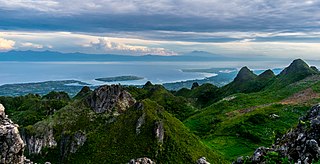
Cebu, also called Cebu Province, officially the Province of Cebu, is a province of the Philippines located in the Central Visayas (Region VII) region, and consists of a main island and 167 surrounding islands and islets. The coastal zone of Cebu is identified as a site of highest marine biodiversity importance in the Coral Triangle.

Bohol, officially the Province of Bohol, is an island province of the Philippines located in the Central Visayas region, consisting of the island itself and 75 minor surrounding islands. It is home to Boholano people. Its capital is Tagbilaran, the largest city of the province. With a land area of 4,821 km2 (1,861 sq mi) and a coastline 261 km (162 mi) long, Bohol is the tenth largest island of the Philippines.

Leyte, officially the Province of Leyte, is a province in the Philippines located in the Eastern Visayas region occupying the northern three-quarters of Leyte Island. Its capital is the city of Tacloban, administered independently from the province, as well as the regional center of Eastern Visayas. Leyte is thus north of Southern Leyte, south of Biliran, and west of Samar Island. To the west across the Camotes Sea is the province of Cebu.

Cebu City, officially the City of Cebu, is a highly urbanized city in the Central Visayas region of the Philippines. According to the 2020 census, it has a population of 964,169 people, making it the sixth-most populated city in the nation and the most populous in the Visayas and in Central Visayas Region.
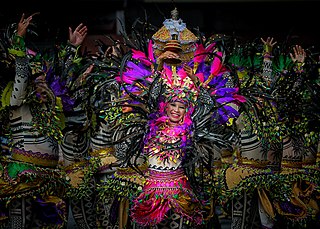
The Sinulog Festival is an annual cultural and religious festival held on the third Sunday of January in Cebu, with the center of the activities being in Cebu City, and is the centre of the Santo Niño Christian celebrations in the Philippines.

Dumaguete, officially the City of Dumaguete, is a component city and capital of the province of Negros Oriental, Philippines. According to the 2020 census, it has a population of 134,103 people. It is the most populous city and the smallest city by land area in Negros Oriental as well as one of the two regional centers in Negros Island Region.
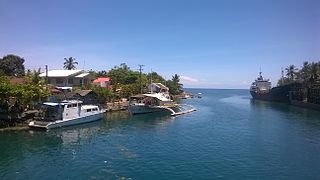
Liloan, officially the Municipality of Liloan, is a municipality in the province of Cebu, Philippines. According to the 2020 census, it has a population of 153,197 people. Making it the most populated municipality in Cebu and the whole Visayas.

Moalboal, officially the Municipality of Moalboal, is a municipality in the province of Cebu, Philippines. According to the 2020 census, it has a population of 36,930 people.
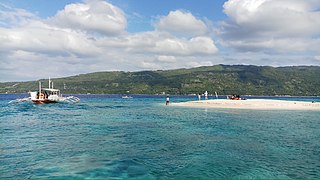
Oslob, officially the Municipality of Oslob, is a municipality in the province of Cebu, Philippines. According to the 2020 census, it has a population of 29,264 people.

Danao, officially the City of Danao, is a component city in the province of Cebu, Philippines. According to the 2020 census, it has a population of 156,321 people.
Rajah Humabon later baptized as Don Carlos Valderrama, was one of the recorded chiefs in Cebu who encountered Ferdinand Magellan in the 16th century. Humabon ruled at the time of the arrival of Portuguese-born Spanish explorer Ferdinand Magellan in the Philippines in 1521. Humabon, his wife, and his subjects were the first known Christian converts in the Philippines. However, since there were no Catholic priests in Cebu from 1521 to 1565, this Christianity was not practised until the return of the Spaniards to Cebu. There is no official record of Humabon's existence before the Spanish contact. The existing information was written by Magellan's Italian voyage chronicler, Antonio Pigafetta on Humabon and the indigenous Philippine peoples that existed prior to Spanish colonization. Rajah Humabon is cited as the reason for why Magellan fought in the Battle of Mactan, as the latter wanted to earn the trust of Humabon by helping him subdue his opponent Lapulapu, one of the chiefs of Mactan. Despite being referred to as "king" in the journal of Antonio Pigafetta, he was not one like in the manner of a monarch in centralized societies, it is plausible that the title was mistakenly applied because according to succeeding chroniclers, there were no kingdoms in the pre-colonial Philippines.

National Museum of the Philippines – Cebu is a museum in Cebu City, Philippines under the National Museum of the Philippines system.

Binignit is a Visayan dessert soup from the central Philippines. The dish is traditionally made with glutinous rice cooked in coconut milk with various slices of sabá bananas, taro, ube, and sweet potato, among other ingredients. It is comparable to various dessert guinataán dishes found in other regions such as bilo-bilo. Among the Visayan people, the dish is traditionally served during Good Friday of Holy Week.

The Carbon Market is the largest market in Cebu City, Philippines. It is the oldest market in the Central Visayas region. As the largest market in the city, various wares are sold in Carbon, including dry goods such as clothing, kitchenware, and handicrafts, as well as wet goods, such as fruits, vegetables, and meat, among other goods, sold by approximately 6,000 vendors in the market.
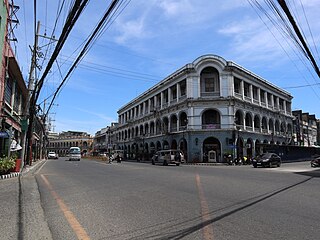
Calle Real, officially named as J.M. Basa Street, is a historic street located in the old downtown district of Iloilo City Proper in Iloilo City, Philippines. It is home to several fine examples of luxury American-era neoclassical, beaux-arts, and art deco buildings. The street has been famous since the Spanish era and once served as the city's main shopping center for more than a century.

Buenaventura Perez Rodriguez was a playwright, the governor of Cebu, Philippines from 1937 until 1940, and a member of the House of Representatives for two terms. He was the first Cebu governor of the Philippine Commonwealth.
Vicente Arandia Gullas was a Filipino writer, lawyer, and educator from Cebu, Philippines. Founder of the Visayan Institute, he introduced innovation in educational system through the establishment of working student and study-now-pay-later schemes and of satellite schools to allow students from locations outside Cebu City. In 2019, he was hailed as one of the top 100 Cebuano personalities.

Ma. Esperanza Christina Codilla Frasco, also known as Christina Garcia Frasco, is a Filipino lawyer and politician serving as Secretary of Tourism since June 30, 2022. She was the mayor of Liloan, Cebu from 2016 to 2022.




















